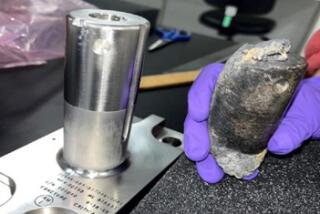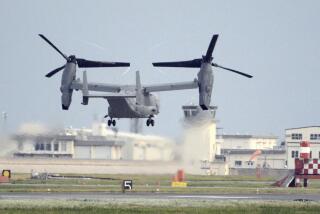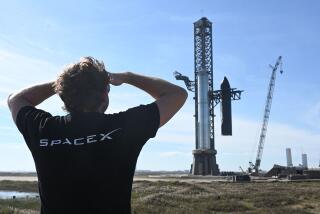Part of Rocket Suspected in Explosion Photographed on Sea Floor
KENNEDY SPACE CENTER, Fla. — Photographs of a submerged piece of one of the shuttle Challenger’s two rocket boosters disclose an unburned joint section that may have been the cause of the Jan. 28 explosion, officials said Thursday.
Navy spokeswoman Lt. Cmdr. Deborah Burnette said crews will recover the 4-by-5-foot wreckage from 650 feet of water to determine if it is indeed part of the shuttle’s right rocket, where the disaster is believed to have originated.
The rocket piece was discovered 32 miles offshore, not far from the spot where other debris from the right-side rocket was found last month. Investigators believe that a synthetic rubber seal device on the joint may have failed, leaking hot gasses and flames that set off the explosion.
Weather Halts Search
Bad weather, meanwhile, forced salvage crews to suspend search efforts Thursday after the delivery of crew compartment wreckage and more remains of the astronauts late Wednesday night.
National Aeronautics and Space Administration officials refused to comment on the delicate recovery process, saying only that “contents and parts” of the compartment had been brought ashore by the Navy salvage ship Preserver.
As the Navy vessel pulled into the dock, several sailors wearing service dress blues stood on deck with hands behind their backs in front of a large, long object described by some witnesses as a flag-draped coffin. Burnette said sailors wear dress blues on ship for ceremonial occasions, including the escort of human remains.
The ship’s commanding officer decided to set an honor guard because of “the solemnity of the occasion,” Burnette said.
Pieces of Compartment
Witnesses said that crews, working from 10 p.m. to 3 a.m., unloaded about a dozen mangled pieces of the crew compartment found in 100 feet of water 18 miles offshore. Some of the pieces were the size of an automobile, they said.
Reported among the items were four flight recorders and some of the five computers aboard the Challenger, which may provide valuable information about the space disaster.
The computers, which were in complete control of the spacecraft during liftoff, may provide data on how the shuttle reacted during the thousandth of a second after the explosion occurred.
NASA announced that it has changed its plans to have autopsies done on the astonaut remains at the nearby Patrick Air Force Base in favor of a larger and more secure laboratory facility at the space center. Crew remains previously recovered were transported by an ambulance from Patrick to the center Wednesday evening, officials said.
Astronaut Jon A. McBride, who described the Challenger’s crew as “family” to him, said in an interview that the anguish he and the other astronauts felt after the explosion has “resurfaced” since the crew cabin containing the remains was found.
“Personally, I’m sorry that they found it,” he said. “I think it would have been better for them to have been buried at sea. That would have been my personal desire.”
He said the astronauts’ confidence in the shuttle program has been shaken and morale is down.
“It’s going to be hard to reach the morale level we had two or three months ago,” he said.
McBride noted that he had felt concern for at least two years that the shuttle program was “moving too fast with too few people,” cutting staff while pushing the shuttles to fly more often.
More to Read
Sign up for Essential California
The most important California stories and recommendations in your inbox every morning.
You may occasionally receive promotional content from the Los Angeles Times.











